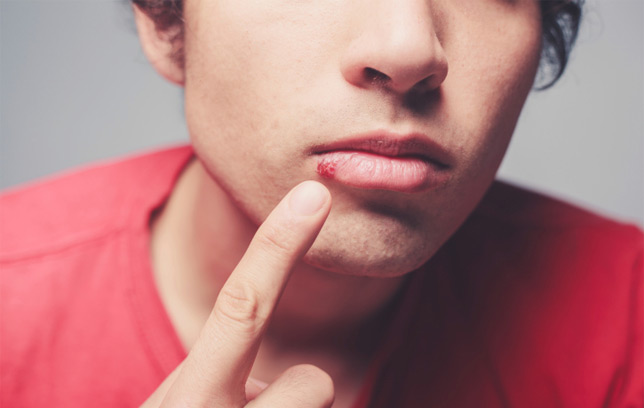That tingling feeling in your lip only means one thing if you’re a cold sore veteran—a new bunch of blisters is set to erupt.
Cold sores are commonly caused by herpes simplex virus type 1, a strain that’s closely related to the type 2 bug responsible for those below-the-belt blisters spread by sexual contact. While cold sores on the lips are mostly spread through casual skin-to-skin contact, oral sex can also spread genital herpes to the mouth area.
Once you pick up the cold sore virus, it lies in wait in your nerve cells until a trigger—say, stress, an illness, dry skin, or even a smack in the gob—prompts it to rear up again. So the best way to avoid an outbreak, then, is to reduce your exposure to certain triggers.
These sores are contagious, uncomfortable, and can be unsightly. The good thing, though, is that they’ll usually clear up on their own within about two weeks. The not-so-swell part? You’ll be sporting some red, oozing, and then crusting blisters right smack on your kisser until then.
But don’t worry—we’ve got you covered. Follow these tips below to send your cold sore packing.
9 Surprising Ways to Whiter Teeth
1. Catch It Early
Cold sores aren’t a wait-and-see condition: Identifying them early is the best way to put the brakes on their arrival.
“You can actually keep it from breaking out, or perhaps keep it from breaking out as badly as it otherwise would,” says Bruce Robinson, M.D., a dermatologist in private practice in New York City and clinical instructor of dermatology at Lenox Hill Hospital.
Be on the lookout for what the docs call the “prodromal stage,” which includes symptoms like tingling, itching, inflammation, or soreness on the area where the sores will later break out. If you feel anything funny, call your doc so you can start treatment.
2. Try an Antiviral
Topical over-the-counter meds don’t really work as well as prescription antivirals do, says Dr. Robinson. They may provide some relief from the tingling and burning, but they’re not the best option if you want the sore gone fast.
The best way to treat cold sores—especially if they’re severe—is to start treatment early in that prodromal stage, with a prescription oral antiviral medication like valacyclovir (which you probably know as Valtrex), says Lorraine Young, M.D., co-chief of dermatology clinical services at UCLA.
A common regimen is to take two, one-gram pills in the morning and then two more later on in the day—this hits the virus hard right when it wants to ramp up its replication.
“It decreases the virus from replicating, so then it will help it to heal faster,” says Dr. Young.
And if you throw a wrench in the virus’s replication early enough, that can disrupt it from going through its normal course. The result? It can reduce the time it takes for your blisters to heal—or it can even prevent them from appearing in the first place.
3. And Add a Steroid Cream
If your doctor has you on oral antiviral meds, you might benefit from including a topical steroid cream in your treatment too, says Dr. Young.
This can help reduce the inflammation associated with the sores, which can make the pain, redness, and irritation feel a little bit better.
Important note: Steroid creams are only an option if you’re on the antiviral drugs. That’s because steroids decrease your body’s ability to fight infections.
“So if you just did the cream, without viral therapy, you would be feeding the cold sore infection,” says Dr. Young. “But if you’re on the antiviral medicines, that could help decrease the symptoms.”
4. Take OTC to the Next Level
Cold sore treatment is most effective if you get to the virus before the blisters actually emerge. But if you’ve waited too long, there still are some things you can do to make it better.
You can try making a Domeboro solution, says Dr. Robinson. Pick up the tablets or a packet of the powder at the drugstore, and dissolve in about 12 to 16 ounces of water. You’ll notice some gunk at the bottom of the glass—that’s okay.
10 Best Over-the-Counter Meds
Then, dunk a thin cloth like a handkerchief or pillowcase in the glass, wring it out, and lay it on the blistering area for about 15 to 30 minutes. Do this 2 to 3 times a day until the sores dry out, making a new batch of the solution each time.
“It sucks the moisture and water out of the blister,” says Dr. Robinson. “I can get someone who has an outbreak to scab within 3 days using that—which otherwise might take a week to 10 days.”
Then, once it’s dry, stop the soaks and keep the area moist with a topical antibiotic ointment like Neosporin. This helps prevent secondary bacterial infection and aids the healing process.
5. Stay Hands-Off
Those red cold sore blisters are packed with fluid, which makes the urge to pop them irresistible for some pickers. A word of advice: Keep your hands away from those suckers.
“People pick at anything on their skin, so it can be tempting to do that,” says Dr. Young. “But anytime you do that, it can get secondarily infected.”
And that’s bad news for your mug: Bacterial infections can make the sores stick around longer, and picking at a bad infection can lead to scarring. So if your blisters seem to be healing slowly, it might not be because the cold sore virus is still there—they just might be infected with bacteria.
If your sores continue to persist beyond that 1 to 2 week window, they become redder or inflamed, or you notice pus, you may have a bacterial infection. See your doc—he or she will probably prescribe a topical or oral antibiotic.
6. Play the Prevention Game
How Stress Causes a Cold Sore
Sun is also a major factor that can set off an outbreak.
“Our immune system is compromised to some degree by ultraviolet light,” says Dr. Robinson. This means you’re less likely to fight off infections at the skin level.
Your move? Whenever you’re going to be out in the sun, slather on a sunscreen with an SPF of at least 30. And don’t forget your lips—make sure to hit that area with some Chapstick with sunscreen.
















